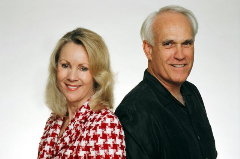

LB DJ Bill "Santa" Lovelace Offers $100 Holiday Discount For LBReport.com Readers. Plan Your Xmas Party Now! Click Here





3853 Atlantic Ave.
|
Click here |
Internet Is Future of News, AP Chief Declares
(November 14, 2004) -- The head of world's largest news organization says the internet is changing the way news is provided...and content is key.
LBReport.com posts in full below the remarks of Tom Curley, President/CEO of The Associated Press, who delivered opening/keynote remarks at a November 12 conference of the Online News Association in Los Angeles.
Long Beach is home to LBReport.com (LongBeachReport.com), one of the country's pioneering, exclusively LBReport.com publisher Bill Pearl agreed that content is key, but added "it always has been. The big difference now is the internet, which is the great equalizer."
Launched in August 2000, LBReport.com has established itself in CA's fifth largest city as an independent news outlet combining Pearl quipped, "Size matters in some things, but not in local news. We work hard to be better. Just ask our readers." LBReport.com is now seeing levels of page views and visitors that some in LB didn't foresee, he added.
The remarks of AP President/CEO Tom Curley follow below:
[begin text]
Remarks by Tom Curley, President and CEO, The Associated Press Delivered at Online News Association Conference, Nov. 12, 2004 On Tuesday, Nov. 2, some 120 million Americans stepped into voting booths around the country, and The Associated Press put nearly 5,000 stringers into the field to count their votes. It was a massive, meticulous job that defines our work as daily journalism's most authoritative and accurate source of breaking news. Some things -- like counting votes and covering wars -- haven't changed much in our 156-year history. We also got it right back in 1848, when the Whig Party's Zachary Taylor defeated Democrat Lewis Cass. But other things in our profession -- and in the business of the news media -- are undergoing dramatic change. This group -- the Online News Association -- was foresighted enough to see it coming back in 1999, when a bunch of you flew into Chicago to organize what today has become much more than just another journalism specialty. Lawrence Lessig says that we need to prepare for the day when "every machine with electricity is essentially on the Net." As that day approaches, we can appreciate the foresight of ONA's founders that you are in a uniquely relevant position. We have the biggest opportunity ever -- and I underscore ever -- to build an audience of news enthusiasts, who will read, write and, yes, even transact some revenue-generating business over the ubiquitous network of the Internet. So, let's explore that historic opportunity, and I'll try to give you a sense of how we see it at The Associated Press. At the start, I'd like to make a subtle, but critical, overall observation about the magnitude of the revolution we're undergoing. The Internet has become our new business environment, not just another medium for distribution. The ubiquity of the Internet now affects a media enterprise's entire business, not just an "online market" segment. While we have dug pretty deeply into how the Internet affects content creation and distribution, we frankly understand much less about its impact on the commerce and business models that support content creation and distribution. Reaching a better understanding of those business issues, and making the necessary adjustments, will be as critical to the next phase of the Internet, as building Web sites was in the first 10 years. When the Web was born as a commercial content enterprise back in the mid-'90s, we thought it was about replicating -- that is, "repurposing" -- our news and information franchises online. Looking back, the first Web sites produced by many newspapers were very close cousins to the paper-and-ink versions. Eventually, things began to change. More multimedia elements were introduced, although that was a painful experience for dialup users, and news companies that were used to one deadline a day began to cover stories differently for real-time consumption. But "Web 1.0" didn't take us much further than that. And, in the past few months, the pace of change has vastly accelerated. Broadband penetration is the key driver of that acceleration. As it zooms beyond 100 million connections worldwide, and half the American Internet population, broadband means more hours spent online, by more people and more machines. We are getting closer and closer to Professor Lessig's vision of "every machine with electricity" moving to the network. That is the essence of what some are now referring to as "Web 2.0" -- the next phase of the network, where the machines are "always on," and the users are, too. This is going to be a period of great change for the media, as we wrestle with many old and new demons at the same time -- legacy technology, silo-ed bureaucracies and entrenched workflows on the one hand, and the killer apps and new voices of the Internet on the other. We have our work cut out for us, even those of us, like you, who have been a part of this revolution from the start. To give you a sense of the battleground as we see it, let me highlight a few of the fundamentals we're focused on. First, content will be more important than its container in this next phase. That's a big shift for old media to come to grips with. Killer apps, such as search, RSS and video-capture software such as Tivo -- to name just a few -- have begun to unlock content from any vessel we try to put it in. Who needs to bookmark and surf a bunch of Web sites anymore, when you can search or monitor several RSS "feeds" much more efficiently? And even though Tivo hasn't exactly taken off in the television space, Microsoft and the cable companies will soon be throwing their full weight behind the trend toward time-shifted, personalized TV viewing. The franchise is not the newspaper; it's not the broadcast; it's not even the Web site. The franchise is the content itself. And in Web 2.0, discrete pieces of content -- stories, photos and video clips -- all categorized and branded, will be dis-assembled from whatever presentation you create and magically re-assembled on the PC desktop, the mobile device or TV set-top box, for consumption on demand. That's the fundamental behind personalization. The content comes to you; you don't have to come to the content. So, get ready for everything to be "Googled," "deep-linked" or "Tivo-ed." "My Personalized News" in the future might look something like this: The latest headlines and photos delivered to my desktop from AP. A video news package from my local TV station and sports highlight clips from ESPN delivered to my set-top box. A list of upcoming earnings reports from The Wall Street Journal downloaded to my PDA. And a BusinessWeek analysis dispatched as a pdf to my wirelessly enabled printer. If this sounds like all the predictions you've heard before, you're almost right. You have heard some of them before, but the difference now is we've seen many of these visions actually materialize -- and shift the landscape. The whole "search" phenomenon -- led by Google and Yahoo -- has demonstrated the power of new tools to "disintermediate" us and "reaggregate" our audiences around search results. The rise of Really Simple Syndication, or RSS, is another example of moving "atomized" content to the desktop in headline form, thus frustrating our expensive attempts to bottle it up or dress it up on fancy homepages. The implications for content providers are enormous. You cannot control the "containers" anymore. You have to let the content flow where the users want it to go, and attach your brand -- and maybe advertising and e-commerce -- to those free-flowing "atoms." The Associated Press, in this context, might end up "branding" facts such as sports polls or rankings, not just stories and photos; The LA Times and other newspapers will have to compete for eyeballs well beyond the boundaries of their published front pages and Web sites. So, after we take a minute to get comfortable with this ice-cold shower of "disintermediation," we need to get cracking at the hard work ahead. And it's some stuff we don't fully understand yet -- like how to free our great content from those expensive containers we've all created -- the newspaper, the broadcast and the Web site -- and tagging our news for delivery in discrete pieces, on demand. And keeping control of our intellectual property. This work has major implications for the way we report the news, as well as how we format it. At AP, for instance, we need to think about a story as the sum of many valuable parts -- an alert, a longer headline, a summary, a bunch of short updates and finally a newspaper workup. All those atomic pieces have greater value in this scenario than we might have imagined. If we're really lucky, they may well have the potential to reverse the trend toward the commoditization of news that we've experienced in the first Internet wave. The second fundamental to recognize is that our audience is clearly shifting -- and changing. All those readers and viewers we've been losing in other media are being engaged as never before in this new media world. But there's a big difference now. The users are deciding what the point of their engagement will be -- what application, what device, what time, what place. That's a huge shift in the "balance of power" in our world, from the content providers to the content consumers. "Appointment-driven" news consumption is quickly giving way to "on-demand" news consumption. And, as we've seen so clearly in the last year or so, consumers will want to use the two-way nature of the Internet to become active participants themselves in the exchange of news and ideas. The news, as "lecture," is giving way to the news as a "conversation." Making that conversation relevant to our core content is a great challenge. AP has had some very good success with one "conversation": warquestions@ap.org, in which we responded to questions about Iraq. Here are some numbers to reflect on, recently published by David Sifry, the master blogger from Technorati.com in San Francisco: There are 4 million bloggers out there on the Internet, making 400,000 posts per day. That works out to roughly 16,000 posts per hour, or about as many stories as the AP sends out in an entire day. And we thought we had a "fire hose!" Some experts estimate that as many as a half-million of those bloggers are actually making money at it. Indeed, only 16 of the top 100 blogs, as tracked by Technorati, are ad-free. So, are we being beaten at our own game? Not really. As we know from the campaign season, this is more about the emergence of an engaged audience, than it is about competition. An active two-way connection to the audience has always been the secret to success in our business, whether you're talking about inspiring a letter to the editor or selling classifieds and cars. We can't help but benefit from this new engagement, and if some of the new "consumer-contributors" become "professionals" in their own right -- well, then, you've got more potential members for ONA. It's a "good thing," as one recently incarcerated publisher used to say. Her personal investment foibles aside, Martha Stewart certainly knows a thing or two about marketing and branding, and brands have a way of transcending the chaos of the marketplace. Which leads me to a third fundamental -- Many new media brands may be born in Web 2.0, but existing household names can also thrive. Established brands in the news business will continue to be extremely important, even as new voices enter the conversation. The expanding "blogosphere" is indeed huge, but the bloggers need a baseline of facts and professional analysis on which to base their work. And that's where the AP and many of the other organizations you all represent come into play. Imagine Drudge without somebody to link to, or Wonkette without somebody to poke fun at. It's a new community that's forming in the news and information space. The "neighbors" may not all like each other, but we're all part of the same network, like it or not. There's really no reason not to like it: If we can ship our content anywhere and let anyone comment on it, and focus even more attention on it, we will rev up a virtuous cycle that will drive eyeballs and ultimately support the new businesses we need to build on the network. At the AP, as you may have heard, we're taking some bold steps into this new world. We've moved into a new headquarters on the west side of Manhattan, where we've installed the central editing desks for every media type in one, wide-open, 100,000-square-foot newsroom for the 21st century. Under the hood, we're overhauling the analog infrastructure of the old "wire service" and dismantling the single-media silos that have served us faithfully over the years but are no longer adequate to meet the challenges ahead. We are shifting from an old "telegraph" model of pushing news to our subscribers through proprietary pipelines to a database model, where our customers can retrieve what they want, when they want it, over the network. Our content is being formatted and databased to facilitate this new on-demand access, and, most important, we're realigning our human resources to cover the kinds of stories people want to read and watch. We're equipping our bureaus worldwide with flashcams. We're adding domestic video to our content portfolio. We've established regional editing desks around the world to drive content from conceptualization to consumption. Politics and breaking news remain a core strength -- as we have demonstrated once again in the election, as well as in Iraq where we spend millions to cover the war and keep our journalists at the front safe. And we also have increased our coverage of financial news, entertainment and news for young audiences. And we're trying to harness the right technologies -- search and RSS in particular -- to plot a strategy for moving AP content where it needs to go in the new, free-flowing world of Web 2.0. According to the latest research by Pew, 29 percent of Internet users go online to access news three or more times each week. That's 43 million people who are such frequent users of news online that we can call them news enthusiasts. AP is working with newspaper and other customers to keep those news enthusiasts on news web sites instead of letting them click off to search engines for news headlines by providing an exciting new multimedia News Search utility that will search not only AP's news but customer news as well. The search utility, which you'll be hearing a ot more about in coming months, will be coupled with an RSS feed to link to AP and customer headlines. AP has always been about speed, at least when it comes to covering the news. Now, we're being challenged to adapt just as swiftly to our changing business environment. Staying focused on the fundamentals is critical amid this upheaval. For us, it's making content mobile and accessible, so it can be delivered on demand, to any application or device, at any time or place. And it's about "lightening" our expense side, so we can make the necessary investments in people and technology to keep riding the big wave that's building. Can the "old media" really "hang ten?" Absolutely. Even with 4 million blogs, doubling every few months, there will still be a big market for facts, as we've seen time and again in news stories, large and small. Ten days ago I saw it dramatized. AP's political correspondent Ron Fournier got the scoop that John Kerry had conceded to George Bush. Pursuing the truth will remain an expensive job, and it will take real money -- not a few cents per click from Google AdSense -- to pay for it. We believe the world needs AP's primary content more than ever, that authoritative voice that we -- and you -- provide, precisely because there are so many new voices and free-flowing content "atoms" out there on the network. As one Netscape executive wryly noted back in '96, "A well-done medium is rare." It's so true -- and this group in particular has seen to it that online journalists get the training they need and the recognition they deserve to enhance the quality and visibility of their work. If this group hadn't stepped forward five years ago -- and held on through the collapse of the first Internet bubble -- some of the great work that you celebrate at this conference might never have been done. Online journalism has arrived, and, fortunately, ONA was already there to greet it. You now lead us into the next phase, where it will get even tougher to be heard above the roar of the Internet crowd, and the business bets will have even greater stakes. We head into that future confidently, alongside you, fully aware both of what we know and what we don't know. And we look to groups like yours to help us understand the demands and opportunities of the developing space. As the analyst Mary Meeker says, the winners in the next phase will be those who can aggregate and engage the most users. Whether that turns out to be Google's servers or our journalists, is a question worth keeping us all up at night as the next phase unfolds. This conference provides all the proof you need of the power of great content. On behalf of The Associated Press, I salute you -- especially your incoming president for 2005, our own Ruth Gersh -- and wish you all the best of luck in your continuing good work.
Contact us: mail@LBReport.com |